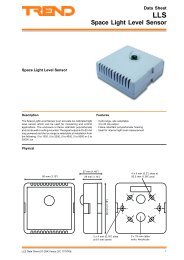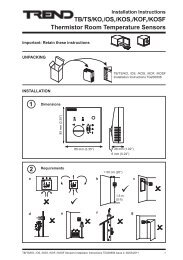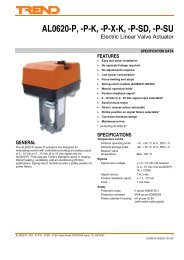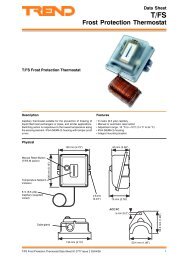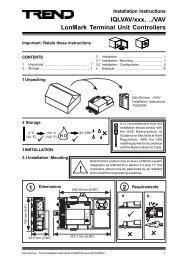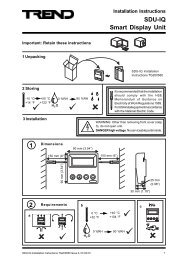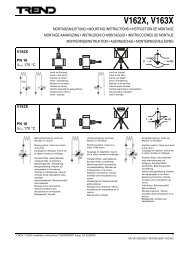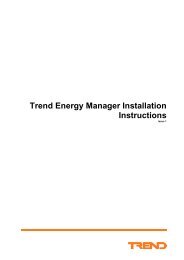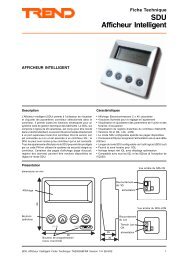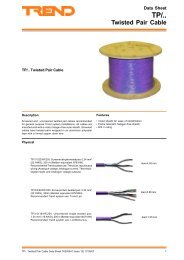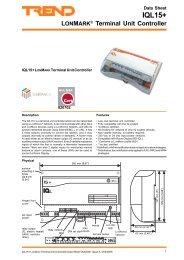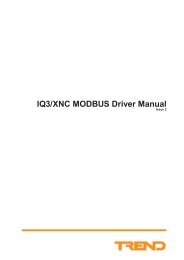IQ204/ADL Autodialling Controller Data Sheet - Trend
IQ204/ADL Autodialling Controller Data Sheet - Trend
IQ204/ADL Autodialling Controller Data Sheet - Trend
Create successful ePaper yourself
Turn your PDF publications into a flip-book with our unique Google optimized e-Paper software.
" 8<br />
" 8<br />
" 8<br />
4 - 8 ) . 6 0 15 + 8 - 4 <br />
- : 2 5 - 5 , ) / - 4 7 5 <br />
8 6 ) / - 5<br />
8 <br />
" 8<br />
<strong>Data</strong> <strong>Sheet</strong><br />
<strong>IQ204</strong>/<strong>ADL</strong><br />
<strong>Autodialling</strong> <strong>Controller</strong><br />
<strong>IQ204</strong>/<strong>ADL</strong> <strong>Autodialling</strong> <strong>Controller</strong><br />
Description<br />
The <strong>IQ204</strong>/<strong>ADL</strong> <strong>Autodialling</strong> <strong>Controller</strong> has 8 analogue inputs, 8<br />
digital inputs and 8 voltage analogue outputs. There is a special<br />
connector for an external 2-line display panel. The controller<br />
provides full Direct Digital Control (DDC) with PID loops. The unit<br />
is enclosed in a robust metal box. The <strong>IQ204</strong> and one other<br />
controller on its local Lan (e.g. an IDxx access controller) can<br />
communicate using the modem.<br />
Features<br />
• 1 second cycle time and extended logging<br />
• integral autodialling facility to external modem<br />
• option to share line (dial out alarms only)<br />
• full DDC control with PID control loops<br />
• stand alone or integrated system operation<br />
• 8 analogue + 8 digital inputs<br />
• 8 voltage analogue outputs<br />
• RS232 or RS485 local supervisor port (if modem disconnected)<br />
• dual strategy non-volatile backup<br />
Physical<br />
earthing<br />
(grounding)<br />
flange<br />
network<br />
connections<br />
input<br />
channels<br />
indicators<br />
<br />
6 <br />
6 <br />
4 6 :<br />
4 <br />
6 <br />
6 4 :<br />
4 <br />
4 <br />
8<br />
, &<br />
) &<br />
, %<br />
) %<br />
, $<br />
) $<br />
, #<br />
) #<br />
8<br />
, "<br />
) "<br />
, !<br />
) !<br />
- 6 9 4 <br />
6 <br />
6 <br />
4 <br />
6 :<br />
4 <br />
6 <br />
4 :<br />
6 <br />
4 <br />
4 <br />
" 8<br />
8<br />
, &<br />
) &<br />
, %<br />
) %<br />
" 8<br />
, $<br />
) $<br />
, #<br />
) #<br />
8<br />
, "<br />
) "<br />
, !<br />
) !<br />
" 8<br />
,<br />
,<br />
)<br />
)<br />
, <br />
, <br />
) <br />
) <br />
8<br />
8<br />
4 - 8 ) . 6 0 15 ) * - 9 1 - : 2 5 - , 1 4 ) 1 7 6 1 / 0 - 5<br />
+ ) 7 6 1 , 6 2 - 4 ) 6 - 6 0 15 7 16 9 16 0 6 0 - 5 - 0 - 5 - : 2 5 - ,<br />
9 ) 4 1 /<br />
6 D EI K EJEI I K F F EA @ I A JJ B= J HO @ A B= K JI M D E D M E= M = <br />
I K F A HL EI HJ @ E= K F = @ K E = JA M EJD JD EI K EJL E= 2 5 6 <br />
M EJD K J= O BK HJD A HI A JJE C BJD EI K EJ<br />
, A B= K JI A JJE C I = HA ) @ @ HA I I $ 5 K F A HL EI HF HJ= @ @ HA I I <br />
% 2 H N O F HJ % <br />
6 D A E A @ A JM H A J HI K F F EA @ K I J> A BEJJA @ EB= = <br />
A JM H EI J A JA @ <br />
4 - 8 ) . 6 0 15 ) * - 9 1 - : 2 5 - , 1 4 ) 1 7 6 1 / 0 - 5<br />
+ ) 7 6 1 , 6 2 - 4 ) 6 - 6 0 15 7 16 9 16 0 6 0 - 5 - 0 - 5 - : 2 5 - ,<br />
" 8<br />
8<br />
* &<br />
8<br />
* %<br />
8<br />
* $<br />
8<br />
* #<br />
8<br />
* "<br />
8<br />
* !<br />
8<br />
*<br />
8<br />
* <br />
8<br />
2 9 - 4 1<br />
-<br />
<br />
<br />
<br />
" 8<br />
<br />
- $ )<br />
8<br />
8 <br />
" 8 <br />
<br />
" 8 <br />
8<br />
* &<br />
8<br />
* %<br />
8<br />
* $<br />
8<br />
* #<br />
8<br />
* "<br />
8<br />
* !<br />
8<br />
*<br />
8<br />
* <br />
8<br />
180 mm (7.09”)<br />
57 mm (2.24”)<br />
230 Vac input power (option)<br />
24 Vac input power (option)<br />
auxiliary output supply<br />
output channels<br />
1 2 7 6<br />
7 6 2 7 6<br />
255 mm (10.04”)<br />
4 5 " & #<br />
, 15 2 ) ; 2 ) - <br />
4 5 ! , JF K C = F K JA HE J JD EI A J H= I J @ I <br />
= O = K I A @ = = C A > JD J JD A F K JA H= @ JD EI K EJ<br />
earthing (grounding)<br />
flange<br />
Supervisor port<br />
RS485<br />
RS232<br />
25 Way D type female<br />
display panel connector<br />
RJ11<br />
adaptor cable (450 mm, 17.72”, supplied)<br />
PSTN Connector<br />
60 mm<br />
(2.36”)<br />
cable length<br />
200 mm<br />
(7.87”)<br />
modem<br />
25 Way D type male<br />
25 mm<br />
(0.98”)<br />
55 mm (2.17”)<br />
<strong>IQ204</strong>/<strong>ADL</strong> Autodailling <strong>Controller</strong> <strong>Data</strong> <strong>Sheet</strong> TA200489 Issue 1/E 01/11/06<br />
1
<strong>IQ204</strong>/<strong>ADL</strong><br />
<strong>Data</strong> <strong>Sheet</strong><br />
FUNCTIONALITY<br />
The IQ <strong>Controller</strong>’s functionality can be divided into four sections; the System, the Strategy, the Firmware, and the Hardware.<br />
SYSTEM<br />
The <strong>IQ204</strong>/<strong>ADL</strong> is able to communicate with other IQ system Building Management System devices (e.g. supervisors and IQ<br />
controllers), using the modem or using the IQ system network. The modem may be unplugged from the supervisor port, and replaced<br />
with a local supervisor type device (e.g. PC).<br />
Quick Start<br />
When the <strong>IQ204</strong>/<strong>ADL</strong> is received ‘out of the box’, the system must first be configured so that a supervisor can dial up and communicate<br />
with the unit using the modem. Any further configuration can then be done using the modem or locally if required with the exception<br />
that a strategy data file cannot be downloaded to the <strong>IQ204</strong> using the modem.<br />
Required Configuration:<br />
1 Plug in modem to supervisor port using adapter cable<br />
provided<br />
2 <strong>IQ204</strong> address switch set in range 11 to 117 (e.g. 16)<br />
3 Supervisor port address = Record module proxy port: set<br />
to be the same - they are set to be the same by factory<br />
default settings (also restored by strategy cleardown) as<br />
follows:<br />
Supervisor port address = address switch + 1 (e.g. 17)<br />
Record module proxy port = address switch + 1 (e.g. 17)<br />
If the address switch is set less than 11 these are set to 20.<br />
Note that the <strong>IQ204</strong> will restore a backed up strategy from strategy<br />
backup module 1, if set up, after a loss of data due to battery<br />
failure and this may change these parameters.<br />
4 network connection: link using ‘loop back’ connector<br />
(supplied) if controller stand-alone.<br />
5 address of second accessible controller: set to be <strong>IQ204</strong><br />
address switch + 2; range 13 to 119 (e.g. 18).<br />
Subsidiary Configuration:<br />
A supervisor or software tool can now be used to dial into the<br />
controller using the modem or to connect locally (in place of the<br />
modem, or on the local Lan) and to configure the following:<br />
1 Address module, Alarm address: set to record module proxy<br />
port address (e.g. 17) to allow controller to send alarms<br />
using modem.<br />
2 Record module, (the following parameters also allow<br />
controller to send alarms using modem).<br />
Address: set to supervisor address on its Lan<br />
Lan: set to supervisor Lan number<br />
3 Telephone number: set to telephone number of modem<br />
being used by supervisor.<br />
4 Autodial module, own telephone number: must be set to<br />
the <strong>IQ204</strong> modem’s telephone number if sending alarms<br />
to a supervisor (e.g. 963).<br />
The supervisor can now communicate with the controller and [controller address + 2], and the 2 controllers will send their alarms to<br />
the supervisor. If the second controller is an access controller the BMS supervisor can retransmit the access alarms to the access<br />
supervisor. A detailed description of autodial lite system functionality is given in the IQ Configuration Manual Addendum.<br />
Communications<br />
Using the above configuration, information within the <strong>IQ204</strong>/<strong>ADL</strong> can be communicated to and from an IQ system supervisor or<br />
software tool.<br />
The <strong>IQ204</strong> can communicate with other local IQ controllers using inter-controller communications (IC comms). If the modem is<br />
connected, the autodialled supervisor can only talk to the two designated controllers, but the <strong>IQ204</strong> can use IC Comms to communicate<br />
to or from other controllers not directly accessible to the supervisor enabling the sharing of information across the whole system.<br />
Note that Inter-<strong>Controller</strong> Communications cannot be used to communicate using the modem.<br />
Note that unlike the TMN, the <strong>IQ204</strong>/<strong>ADL</strong> cannot be on an internetwork, and does not use the next five addresses.<br />
Note that although a strategy data file can be uploaded using the modem (backup) it cannot be downloaded using the modem to the <strong>IQ204</strong>;<br />
a file can be downloaded to the second controller at [address + 2].<br />
2 <strong>IQ204</strong>/<strong>ADL</strong> Autodailling <strong>Controller</strong> <strong>Data</strong> <strong>Sheet</strong> TA200489 Issue 1/E 01/11/06
<strong>Data</strong> <strong>Sheet</strong><br />
<strong>IQ204</strong>/<strong>ADL</strong><br />
STRATEGY<br />
The strategy processes inputs according to a set of instructions and then outputs signals which can be used to control equipment.<br />
Configuration: The <strong>IQ204</strong>/<strong>ADL</strong> uses the standard IQ<br />
configuration mode which enables configuration using the<br />
network, or using the supervisor port (either using modem or by<br />
local PC). SET can be used to create a strategy data file (.IQ2)<br />
which can then be downloaded to the controller if connected to<br />
the controller directly or using the network. The strategy file can<br />
be uploaded using the modem for backup purposes.<br />
Modules: The strategy consists of a number of individual<br />
functional blocks known as configuration modules. These blocks<br />
can be linked in various combinations to enable equipment to be<br />
controlled in accordance with the building’s requirements. The<br />
table lists the different types of configuration modules and the<br />
number of each type available with <strong>IQ204</strong>/<strong>ADL</strong>.<br />
Module<br />
Type<br />
Number<br />
Module<br />
Type<br />
Number<br />
Sensor<br />
32<br />
Critical<br />
Alarm<br />
4<br />
Sensor<br />
type<br />
10<br />
Alarm History<br />
20<br />
Loop<br />
16<br />
IC Comms<br />
16<br />
Function<br />
120<br />
Digital<br />
Inputs<br />
32<br />
Logic<br />
120<br />
Fast<br />
Sequence<br />
8<br />
Driver<br />
12<br />
Zone<br />
5<br />
Knob<br />
60<br />
Schedule<br />
8<br />
Switch<br />
60<br />
Calendar<br />
20<br />
Sensor<br />
log<br />
20<br />
User<br />
Password<br />
6<br />
Sequence<br />
step 240<br />
Sequence<br />
time<br />
1 s<br />
Analogue<br />
Nodes 510<br />
Digital<br />
Nodes<br />
1012<br />
Display<br />
140<br />
Directory<br />
25<br />
Group<br />
10<br />
Route<br />
50<br />
Destination<br />
7 New Alarm Log<br />
100<br />
autodial<br />
1 record<br />
1<br />
delay<br />
list<br />
1 modem<br />
1<br />
Full details of the modules are given in the IQ Configuration<br />
Manual and Addendum. The <strong>IQ204</strong>/<strong>ADL</strong> also contains the<br />
standard IQ2 features as described in IQ Configuration Manual<br />
Addendum: Engineers Journal (J), I/O Summary (i/o) Loader<br />
Issue (R(c), ’c’ lower case), Serial Number (R(s), ‘s’ lower case),<br />
Supply Frequency Option, Enhanced Logging, Module position,<br />
and Strategy Cleardown.<br />
Differences between the modules covered in the manuals and<br />
the <strong>IQ204</strong>’s modules are described below.<br />
Line Sharing: As explained in the manuals, changing modem<br />
initialisation string 2 in the modem module (to ATS0=0) enables<br />
the modem to share a line; the modem can dial out with alarms,<br />
but it will ignore incoming calls, so cannot be accessed from a<br />
supervisor.<br />
Dual Strategy Backup: Two strategy files may be stored in nonvolatile<br />
memory (i.e. retention is independent of controller's<br />
battery). The strategy backup modules can be accessed in<br />
configuration mode by character '#'. There are two modules (#1<br />
or #2). Since the controller will load the strategy from module 1<br />
if it detects a corrupted memory condition, it is recommended to<br />
keep module 1 as the current strategy backup.<br />
STRATEGY 1<br />
date 22/08/00<br />
Save to flash 0<br />
Restore from flash 0<br />
=<br />
Entering 'S1' will cause the controller to respond with the following<br />
message while it suspends strategy operation and saves the<br />
strategy to the relevant strategy backup module in non-volatile<br />
memory:<br />
'Please wait saving strategy to location 1'<br />
Entering 'R1' will cause the controller to respond with the following<br />
message while it suspends strategy operation and restores the<br />
strategy from the relevant strategy backup module in non-volatile<br />
memory:<br />
'Please wait restoring strategy from location<br />
1'<br />
The instructions can be given by text comms commands e.g.<br />
'#1(S=1)' causes a save to module 1, and '#2'(R=1) causes a<br />
restore from module 2. IQ system software tools can implement<br />
these commands by text comms or configuration mode; the GDP+<br />
can be programmed to execute the commands using text comms.<br />
It is recommended that the running strategy is backed up in<br />
strategy backup module 1 so that it will be restored after a strategy<br />
cleardown due to a faulty battery. Backup module 2 may then be<br />
used to store a default or alternative strategy.<br />
Strategy Cleardown: The <strong>IQ204</strong> has a modified version of IQ2v3<br />
strategy cleardown because it is able to restore the strategy from<br />
a strategy backup module. If there is a strategy file backed up in<br />
module 1, it will restore the file after loss of data during power<br />
down due to a faulty battery (i.e. checksum error or checksum<br />
invalid). If there isn't a strategy file backed up in module 1, it will<br />
null down the memory, set the address module ID and attributes<br />
to indicate 'Strategy Erased', and enter a CONL condition<br />
(<strong>Controller</strong> on line - restart).<br />
Note that the time, date, and day of week will need to be set up;<br />
this can be done automatically by a timemaster.<br />
Other methods of strategy cleardown act as normal and leave<br />
the controller with a null strategy and any strategies backed up<br />
will still be set up in the strategy backup modules; however, a<br />
firmware upgrade will clear down the strategy backup modules.<br />
<strong>IQ204</strong>/<strong>ADL</strong> Autodailling <strong>Controller</strong> <strong>Data</strong> <strong>Sheet</strong> TA200489 Issue 1/E 01/11/06<br />
3
6 <br />
6 <br />
4 <br />
4 <br />
6 <br />
6 <br />
4 <br />
4 <br />
" 8<br />
8<br />
, &<br />
) &<br />
, %<br />
) %<br />
" 8<br />
, $<br />
) $<br />
, #<br />
) #<br />
8<br />
, "<br />
) "<br />
, !<br />
) !<br />
" 8<br />
,<br />
)<br />
, <br />
) <br />
8<br />
<br />
6 :<br />
4 :<br />
1 2 3<br />
4 5 6<br />
7 8 9<br />
0<br />
<br />
6 :<br />
4 :<br />
1 2 7 6<br />
- 6 9 4 <br />
6 <br />
6 <br />
4 <br />
4 <br />
6 <br />
6 <br />
4 <br />
4 <br />
" 8<br />
8<br />
, &<br />
) &<br />
, %<br />
) %<br />
" 8<br />
, $<br />
) $<br />
, #<br />
) #<br />
8<br />
, "<br />
) "<br />
, !<br />
) !<br />
" 8<br />
,<br />
)<br />
, <br />
) <br />
8<br />
OK OK NETWORK<br />
T-<br />
T-<br />
T+<br />
T+<br />
R- TX<br />
R-<br />
R+<br />
TX<br />
R+<br />
T-<br />
T-<br />
RX<br />
T+ RX<br />
T+<br />
R-<br />
R-<br />
R+<br />
R+<br />
24V<br />
24V<br />
0V<br />
0V<br />
D8<br />
D8<br />
A8<br />
A8<br />
D7<br />
D7<br />
A7<br />
A7<br />
24V<br />
24V<br />
D6<br />
D6<br />
A6<br />
A6<br />
D5<br />
D5<br />
A5<br />
A5<br />
0V<br />
0V<br />
D4<br />
D4<br />
A4<br />
A4<br />
D3<br />
D3<br />
A3<br />
A3<br />
24V<br />
24V<br />
D2<br />
D2<br />
A2<br />
A2<br />
D1<br />
D1<br />
A1<br />
A1<br />
0V<br />
0V<br />
INPUT<br />
1 2 3<br />
4 5 6<br />
7 8 9<br />
0<br />
NDP<br />
" 8<br />
8<br />
* &<br />
8<br />
* %<br />
8<br />
* $<br />
8<br />
* #<br />
8<br />
* "<br />
8<br />
* !<br />
8<br />
*<br />
8<br />
* <br />
8<br />
2 9 - 4 1<br />
-<br />
<br />
<br />
- $ )<br />
8<br />
7 6 2 7 6<br />
8 <br />
8 <br />
)<br />
*<br />
+<br />
,<br />
" 8<br />
8<br />
* &<br />
8<br />
* %<br />
8<br />
* $<br />
8<br />
* #<br />
8<br />
* "<br />
8<br />
* !<br />
8<br />
*<br />
8<br />
* <br />
8<br />
POWER IN<br />
24V<br />
0V<br />
B8<br />
0V<br />
B7<br />
0V<br />
B6<br />
0V<br />
B5<br />
0V<br />
B4<br />
0V<br />
B3<br />
0V<br />
B2<br />
0V<br />
B1<br />
0V<br />
E<br />
N<br />
(0V)<br />
~(24V)<br />
E160 mA<br />
0V<br />
(0V)<br />
OUTPUT<br />
A<br />
B<br />
C<br />
D<br />
24V<br />
0V<br />
B8<br />
0V<br />
B7<br />
0V<br />
B6<br />
0V<br />
B5<br />
0V<br />
B4<br />
0V<br />
B3<br />
0V<br />
B2<br />
0V<br />
B1<br />
0V<br />
, 2<br />
DP<br />
<strong>IQ204</strong>/<strong>ADL</strong><br />
<strong>Data</strong> <strong>Sheet</strong><br />
HARDWARE<br />
Box: The unit is enclosed in a metal box. This provides a robust<br />
construction, and in conjunction with the multi-layer board provides<br />
excellent EMC performance. The box is mounted using the four 'u' slots<br />
on the outside of the unit. There are four holes in the cover normally<br />
covered by labels which can be used for fitting two lengths of DIN rail.<br />
Connectors: Two part connectors are used throughout. Input<br />
power connectors have enhanced creepage and clearance.<br />
Earthing (grounding) flanges are provided adjacent to the I/O<br />
terminals to terminate cable screens.<br />
Power: The <strong>IQ204</strong> can be supplied in 230 Vac or 24 Vac versions.<br />
Displays: The <strong>IQ204</strong>/<strong>ADL</strong> may have an optional 2-line display<br />
panel (HDP or FPK) connected. If the modem is removed from<br />
the local supervisor connector, either a local PC (e.g. supervisor),<br />
a Network Display Panel (NDP), or a Generic Display Panel<br />
(GDP+ - which can be either RS232 or RS485) may be connected.<br />
2-line Display Panel A 2-line display panel (FPK or HDP) can be<br />
mounted externally and connected using the display panel<br />
connector, to provide access to parameters within the controller.<br />
It gives the only indication of the call connection status, so it is<br />
useful to have a display panel fitted either permanently or<br />
temporarily for commissioning purposes.<br />
Fusing: The controller has no replaceable fuses: protection is<br />
provided by means of a self-resetting thermally protected<br />
transformer. The 24 Vac version has a solid state multifuse.<br />
<br />
" 8 <br />
" 8 <br />
" 8 <br />
Network: The network terminals will facilitate connection of 4 wire,<br />
or 2 wire cables. The standard IQ system current loop node features<br />
are included (Lan OK, TX and RX indicators, bypass relay, network<br />
alarm generation). There is also the facility for connection of a<br />
supervisor, network display panel, or GDP+ to the network using the<br />
controller without the need for additional node controllers.<br />
Modem: The modem is connected to the RS232 RJ11 supervisor port<br />
by the adaptor cable supplied with the <strong>IQ204</strong>/<strong>ADL</strong>. It is capable of<br />
V22bis (2400 bps), V22 (1200 bps), and V21 (300 bps) and supports<br />
V25 active handshake protocol. It will communicate only with a TMN<br />
(TMN v4 or greater, V22bis). It consumes 20 mA maximum (equivalent)<br />
from 24 V input power when in use. The modem is compatible with most<br />
major networks in the world. It complies with FCC Part 68 USA, IC CS03<br />
Canada, TS 002 Australia, and CTR21, for use with all telephone networks<br />
of the European Union.<br />
Address/Baud rate switch: The address on the Lan is set by<br />
poles 1 to 7 in the range 11 to 117 and must be unique on the Lan.<br />
(The normal address range is allowed (1, 4 to 9, 11 to 119), but<br />
if another controller on the local network is to dial out using the<br />
modem, its address must also be valid; additionally the default<br />
address setting mechanism uses the address switch plus one<br />
rule for address 11 and greater so this is recommended as the<br />
lowest address, resulting in a recommended range of 11 to 117).<br />
The baud rate is set by poles 8 to 10 in the range 1k2, 9k6, 19k2,<br />
and must match the other nodes on the Lan.<br />
The address and baud rate switch may also be used to perform<br />
a strategy cleardown; this is done by setting all the poles to zero<br />
before power up (see installation instructions, TG200490 sheet<br />
4 and IQ Configuration Manual Addendum). For this reason the<br />
address should normally be set to non-zero.<br />
Local Supervisor Port: By default the local supervisor port is set<br />
to RS232 and intended for connection to the modem. If the modem<br />
is disconnected the RS232 interface (RJ11 socket) can be used for<br />
direct connection of a local supervisor, NDP, or GDP+/RS232.<br />
The local supervisor port can be switched to either RS232 or<br />
RS485 by internal link (J5). The RS485 interface (RJ45 socket)<br />
is for direct connection of a GDP+/RS485; to use it, a flange<br />
covering the RJ45 connector must be bent and snapped off.<br />
The RS232 J11 connects using adapter cable CABLE/EJ101442<br />
to a local supervisor, using adapter cable EJ104029 to an NDP,<br />
or using a special adaptor cable (e.g. RS477-450, 3 meters) to<br />
a GDP+/RS232. The RS485 RJ45 connects using a special<br />
adaptor cable (RJ45 to RJ45 plugs, not crossed-over e.g. RS446-<br />
686, 3 m, 3.25 yds) to a GDP+/RS485. The RS485 interface gives<br />
increased distance compare to RS232 (up to about 100 m, 110 yds).<br />
And, if the modem is disconnected:<br />
PC, NDP, or GDP+/RS232: A computer running a IQ system<br />
Supervisor or Engineering Tool, an NDP or a GDP+/RS232 can<br />
be connected using the controller’s RS232 interface (RJ11<br />
connector).<br />
or GDP+/RS485: A GDP+/RS485 may be connected using the<br />
controller's RS485 interface (RJ45 connector).<br />
The RS232 and RS485 interfaces are alternative interfaces to the<br />
local supervisor port (see below) and enable access to all devices<br />
on the network, as if connected using a separate node controller.<br />
local port RS232<br />
local port RS485<br />
GDP+/RS485<br />
Note that only one device<br />
can be connected to the<br />
local supervisor port.<br />
NDP<br />
Battery Backup: Details about the strategy configuration, time<br />
and date, and logged data are stored in RAM. A plug-in lithium<br />
cell provides power to maintain the data in the event of power<br />
failure, or the controller being switched off.<br />
Indicators: LED indicators for receive and transmit network<br />
current (RX, TX, both yellow) and Lan OK (OK - green) visible<br />
externally. See specification section for details.<br />
PC<br />
L ~<br />
24 V (24V) ~ ~<br />
GDP+/RS232<br />
2-line display<br />
panel<br />
connector<br />
FPK<br />
or<br />
HDP<br />
The NDP and GDP+ take their input power from the <strong>IQ204</strong> using<br />
the adaptor cable.<br />
4 <strong>IQ204</strong>/<strong>ADL</strong> Autodailling <strong>Controller</strong> <strong>Data</strong> <strong>Sheet</strong> TA200489 Issue 1/E 01/11/06
<strong>Data</strong> <strong>Sheet</strong><br />
<strong>IQ204</strong>/<strong>ADL</strong><br />
HARDWARE (Continued)<br />
Auxiliary output supply: An auxiliary output supply of 24 Vdc at<br />
200 mA is available at terminals on the input and output rails.<br />
This is in addition to the full complement of inputs, outputs, NDP<br />
or GDP+, and an external 2-line display panel. If the modem is<br />
in use, it consumes the equivalent of 20 mA maximum (reduces<br />
auxiliary output supply to 180 mA).<br />
If more current is required from the auxiliary output supply, it can<br />
be compensated for by reducing input consumption.<br />
The auxiliary output supply is part of a 24 Vdc supply protected<br />
by a 500 mA self-resetting thermal device (effectively 380 mA at<br />
maximum temperature, 45 °C, 113 °F). This protected supply<br />
powers the inputs and the auxiliary output supply.<br />
# )<br />
I A @ = HO F H JA JE <br />
E F K JI<br />
= K N EE= HO I K F F O<br />
@ A ) <br />
The current consumed by these items is shown in the table:<br />
Area<br />
Inputs<br />
Analogue<br />
Digital<br />
Modem<br />
V<br />
oltage<br />
Load<br />
Item<br />
Current<br />
(IQ powered)<br />
Current<br />
(externally powered)<br />
Thermistor<br />
Auxiliary<br />
Supply<br />
24 Vdc Current<br />
P er Channel<br />
Total (maximum)<br />
0 mA<br />
20<br />
mA<br />
160 mA<br />
0 mA<br />
0 mA<br />
2 mA<br />
16 mA<br />
total<br />
20 mA<br />
180 mA<br />
376 mA<br />
For example:<br />
If an <strong>IQ204</strong>/<strong>ADL</strong> with modem connected has 8 digital inputs, 4<br />
voltage and 4 current (IQ supplied) inputs, what current can be<br />
taken from the auxiliary output supply<br />
ignore voltage inputs<br />
digital inputs (8 x 2)<br />
16 mA<br />
analogue current inputs (4 x 20) 80 mA<br />
modem<br />
20 mA<br />
Available for auxiliary output supply = 380 -16- 80 - 20 = 264mA<br />
I/O Channels: the <strong>IQ204</strong> is supplied with 8 digital inputs, 8 analogue inputs and 8 analogue outputs (voltage only).<br />
Digital inputs (Channels D1 to D8)<br />
Analogue voltage outputs (Channels B1 to B8)<br />
, <br />
<br />
" 8<br />
! !<br />
" 8<br />
" 8<br />
8<br />
4<br />
4<br />
2 <br />
Analogue inputs (Channels A1 to A8)<br />
The channels can be linked for thermistor (T), current (I), or<br />
voltage (V).<br />
8<br />
8<br />
<br />
# 8<br />
) <br />
" 4<br />
& <br />
1<br />
8 6<br />
8<br />
<br />
8<br />
" 8<br />
8<br />
" 8<br />
6 1 8<br />
The current sensor, I, is IQ powered. For an externally powered<br />
current sensor, the channel should be linked for I, and connected<br />
as a voltage input, V.<br />
<strong>IQ204</strong>/<strong>ADL</strong> Autodailling <strong>Controller</strong> <strong>Data</strong> <strong>Sheet</strong> TA200489 Issue 1/E 01/11/06<br />
5
<strong>IQ204</strong>/<strong>ADL</strong><br />
<strong>Data</strong> <strong>Sheet</strong><br />
COMPATIBILITY<br />
Supervisors:<br />
94x series, 921, 96x, ViewPoint+<br />
Utility software: PowerTool, 822+/Toolbox version 6, 841<br />
Strategy Browser (Vx), 842 Change<br />
Tracker, SET, 915 (using v4.2 TMN)<br />
<strong>Controller</strong>s:<br />
Interface:<br />
Local Display:<br />
It can communicate to other IQ controllers<br />
using inter-controller communications (not<br />
using modem)<br />
It can be connected to IQ system interface<br />
modules. Check interface module<br />
specification to ensure compatibility.<br />
Network Display Panel, GDP+, 2-line<br />
Display Panel (all external).<br />
<strong>Autodialling</strong> Devices :Modem connects to TMN (v4.0 or greater,<br />
V22bis)<br />
Using TMN: Prefixing the number used by the TMN to dial into<br />
an <strong>IQ204</strong>/<strong>ADL</strong> with the letters ‘IQ’ will speed up the connection.<br />
If dialling from a 945, the 945 must have the Lan number to which<br />
it dials set as Lan 1 (the <strong>IQ204</strong>/<strong>ADL</strong> ignores the Lan number).<br />
Modem Modules: Downloading an IQ2 or IQF strategy data file<br />
from an earlier version of IQ will set the modem modules to<br />
default. Downloading a data file from an <strong>IQ204</strong>/<strong>ADL</strong> version 3 or<br />
greater will include the modem module settings.<br />
Strategy and Sensor Logs: The IQ Configuration Manual<br />
Addendum covers the compatibility between different types of<br />
strategy files, and between the <strong>IQ204</strong> sensor logs and supervisors<br />
and software tools.<br />
FIELD MAINTENANCE<br />
The IQ <strong>Controller</strong> requires virtually no routine maintenance, however it is recommended that the lithium battery be replaced every<br />
5 years as explained in the <strong>IQ204</strong>/<strong>ADL</strong> Installation Instructions - TG200490 (Replacing Battery).<br />
INSTALLATION<br />
The <strong>IQ204</strong>/<strong>ADL</strong> <strong>Controller</strong> is installed in a cabinet or panel, using 4 screws and washers. For <strong>IQ204</strong>/<strong>ADL</strong>/USA, the unit is UL rated<br />
as ‘UL916, open energy management equipment’. The procedure involves:<br />
Mounting the controller in position<br />
Fitting DIN rail on cover if required<br />
Connecting power, do not power up<br />
Connecting /<strong>ADL</strong> adapter cable to RS232 local supervisor<br />
port (RJ11 connector)<br />
Connecting modem to <strong>IQ204</strong> using adapter cable<br />
Connecting modem to PSTN<br />
Connecting the network or connect network loop-back<br />
connector (supplied) if stand-alone<br />
Terminating the I/O, leave unconnected<br />
Connecting the auxiliary output supply output, if used<br />
Connecting any input or output interfaces (mount on DIN<br />
rail if fitted)<br />
Removing cover<br />
Specifing network address and baud rate<br />
Performing input channel linking<br />
Replacing cover<br />
Disconnecting I/O, network<br />
Powering up<br />
Checking network<br />
If configuring <strong>IQ204</strong> locally, replace modem with PC (software<br />
configuration tool), else configure using modem<br />
configure the strategy.<br />
If applicable, replacing PC with modem<br />
Connecting inputs and test<br />
Connecting outputs and test<br />
Storing strategy to strategy backup module 1 in <strong>IQ204</strong> if required<br />
Backing up strategy to file if required<br />
Note that a 2-line display panel can facilitate commissioning by displaying the dialling status.<br />
This installation procedure, is covered by the <strong>IQ204</strong>/<strong>ADL</strong> Installation Instructions (TG200490).<br />
6 <strong>IQ204</strong>/<strong>ADL</strong> Autodailling <strong>Controller</strong> <strong>Data</strong> <strong>Sheet</strong> TA200489 Issue 1/E 01/11/06
" 8<br />
" 8<br />
" 8<br />
4 - 8 ) . 6 0 15 + 8 - 4 <br />
- : 2 5 - 5 , ) / - 4 7 5 <br />
8 6 ) / - 5<br />
8 <br />
" 8<br />
<strong>Data</strong> <strong>Sheet</strong><br />
<strong>IQ204</strong>/<strong>ADL</strong><br />
INSTALLATION (Continued)<br />
CONNECTIONS<br />
Network<br />
2 part connections for screw terminals, 0.5 to 2.5 mm 2 cross<br />
section area (14 to 20 AWG) cables.<br />
Connection to R+,R- of<br />
previous device polarity<br />
independent<br />
earth (ground)<br />
flange<br />
Terminate screen at transmit<br />
end of cable<br />
Cutback screen at receive end<br />
Connect to T+,T- of next<br />
device polarity independent<br />
Connection to T, R of<br />
previous device polarity<br />
independent<br />
earth (ground)<br />
flange<br />
Terminate screen at transmit<br />
end of cable<br />
Cutback screen at<br />
receive end<br />
4 4<br />
6 6<br />
6 6 4 4<br />
6 <br />
6 <br />
4 <br />
4 <br />
6 <br />
6 <br />
4 <br />
4 <br />
6 <br />
6 <br />
4 <br />
4 <br />
6 <br />
6 <br />
4 <br />
4 <br />
Connect loop back<br />
connectors (supplied)<br />
if not networked<br />
6 <br />
6 <br />
4 <br />
4 <br />
6 <br />
6 <br />
4 <br />
4 <br />
earth (ground)<br />
flange<br />
230 Vac Input power<br />
2 part connector<br />
-<br />
<br />
<br />
6 <br />
6 <br />
4 <br />
4 <br />
6 <br />
6 <br />
4 <br />
4 <br />
8<br />
, &<br />
) &<br />
, %<br />
) %<br />
, $<br />
) $<br />
, #<br />
) #<br />
8<br />
, "<br />
) "<br />
, !<br />
) !<br />
,<br />
)<br />
, <br />
) <br />
8<br />
<br />
<br />
6 :<br />
4 :<br />
<br />
6 :<br />
4 :<br />
1 2 7 6<br />
- 6 9 4 <br />
4 <br />
6 <br />
6 <br />
4 <br />
4 <br />
8<br />
, &<br />
) &<br />
, %<br />
) %<br />
, $<br />
) $<br />
, #<br />
) #<br />
8<br />
, "<br />
) "<br />
, !<br />
) !<br />
,<br />
)<br />
6 <br />
6 <br />
4 <br />
" 8<br />
" 8<br />
" 8<br />
, <br />
) <br />
8<br />
E<br />
N<br />
L<br />
4 - 8 ) . 6 0 15 ) * - 9 1 - : 2 5 - , 1 4 ) 1 7 6 1 / 0 - 5<br />
, 6 2 - 4 ) 6 - 6 0 15 7 16 9 16 0 6 0 - 5 - 0 - 5 - : 2 5 - ,<br />
+ ) 7 6 1 <br />
4 5 " & #<br />
230 Vac<br />
9 ) 4 1 /<br />
6 D EI K EJEI I K F F EA @ I A JJ B= J HO @ A B= K JI M D E D M E= M = <br />
I K F A HL EI HJ @ E= K F = @ K E = JA M EJD JD EI K EJL E= 2 5 6 <br />
M EJD K J= O BK HJD A HI A JJE C BJD EI K EJ<br />
, A B= K JI A JJE C I = HA ) @ @ HA I I $ 5 K F A HL EI HF HJ= @ @ HA I I <br />
% 2 H N O F HJ % <br />
6 D A E A @ A JM H A J HI K F F EA @ K I J> A BEJJA @ EB= = <br />
A JM H EI J A JA @ <br />
, 15 2 ) ; 2 ) - <br />
4 5 ! , JF K C = F K JA HE J JD EI A J H= I J @ I <br />
= O = K I A @ = = C A > JD J JD A F K JA H= @ JD EI K EJ<br />
24 Vac Input power<br />
(option) 24 Vac<br />
4 - 8 ) . 6 0 15 ) * - 9 1 - : 2 5 - , 1 4 ) 1 7 6 1 / 0 - 5<br />
, 6 2 - 4 ) 6 - 6 0 15 7 16 9 16 0 6 0 - 5 - 0 - 5 - : 2 5 - ,<br />
+ ) 7 6 1 <br />
" 8 <br />
8<br />
" 8<br />
8<br />
* &<br />
8<br />
* %<br />
8<br />
* $<br />
8<br />
* #<br />
8<br />
* "<br />
8<br />
* !<br />
8<br />
*<br />
8<br />
* <br />
8<br />
2 9 - 4 1<br />
-<br />
<br />
<br />
<br />
" 8<br />
<br />
- $ )<br />
8<br />
7 6 2 7 6<br />
8 <br />
" 8 <br />
<br />
" 8 <br />
8<br />
* &<br />
8<br />
* %<br />
8<br />
* $<br />
8<br />
* #<br />
8<br />
* "<br />
8<br />
* !<br />
8<br />
*<br />
8<br />
* <br />
8<br />
24 Vac<br />
E<br />
0 V<br />
Do not plug a computer into this<br />
connector as to do so may cause damage<br />
both to the computer and this unit<br />
earth<br />
(ground)<br />
flange<br />
Connect to T, R of next<br />
device polarity<br />
independent<br />
Inputs<br />
2 part connections for screw<br />
terminals, 0.5 to 2.5 mm 2<br />
cross section area (14 to 20<br />
AWG) cables - Cu only.<br />
" 8<br />
8<br />
, &<br />
) &<br />
, %<br />
) %<br />
" 8<br />
, $<br />
) $<br />
, #<br />
4 4 6 6<br />
Local Port, RS485<br />
RJ45 (FCC68)<br />
If modem disconnected<br />
GDP+/RS485<br />
RJ45 to RJ45<br />
special<br />
e.g. RS446-686<br />
Local Port, RS232<br />
2-line Display Port<br />
Connect using cable<br />
supplied with display<br />
panel - 25 Way D type<br />
Supervisor<br />
RJ11 to 9 way ’D’<br />
cable<br />
CABLE/EJ101442<br />
Outputs<br />
2 part connections for screw<br />
terminals, 0.5 to 2.5 mm 2<br />
cross section area (14 to 20<br />
AWG) cables - Cu only.<br />
8<br />
* &<br />
8<br />
* %<br />
8<br />
* $<br />
8<br />
* #<br />
" 8<br />
) #<br />
8<br />
, "<br />
) "<br />
, !<br />
) !<br />
" 8<br />
,<br />
)<br />
, <br />
) <br />
8<br />
A1 to A8 analogue inputs<br />
(V,I,T) D1 to D8 digital inputs<br />
Connect modem<br />
for default use<br />
RJ11 (FCC68)<br />
adapter cable<br />
(supplied)<br />
modem<br />
PSTN<br />
If modem<br />
disconnected<br />
either<br />
NDP<br />
GDP+/RS232<br />
RJ11 to 9 way ’D’ and<br />
2 screw terminals<br />
CABLE/EJ104029<br />
RJ11 to RJ11<br />
special<br />
e.g. RS477-450<br />
8<br />
* "<br />
8<br />
* !<br />
8<br />
*<br />
8<br />
* <br />
8<br />
B1 to B8<br />
analogue voltage outputs<br />
<strong>IQ204</strong>/<strong>ADL</strong> Autodailling <strong>Controller</strong> <strong>Data</strong> <strong>Sheet</strong> TA200489 Issue 1/E 01/11/06<br />
7
<strong>IQ204</strong>/<strong>ADL</strong><br />
<strong>Data</strong> <strong>Sheet</strong><br />
DISPOSAL<br />
COSHH (Control of Substances Hazardous to Health - UK<br />
Government Regulations 2002) ASSESSMENT FOR DISPOSAL<br />
OF <strong>IQ204</strong>/<strong>ADL</strong>. The only part affected is the lithium battery which<br />
must be disposed of in a controlled way.<br />
RECYCLING.<br />
All plastic and metal parts are recyclable. The printed circuit<br />
board may be sent to any PCB recovery contractor to recover<br />
some of the components for any metals such as gold and silver.<br />
WEEE Directive :<br />
At the end of their useful life the packaging,<br />
product, and batteries should be disposed of<br />
by a suitable recycling centre.<br />
Do not dispose of with normal household waste.<br />
Do not burn.<br />
ORDER CODES<br />
Non USA Order Code USA Order Code<br />
<strong>IQ204</strong>/<strong>ADL</strong>/UK/230 not available in USA <strong>IQ204</strong> with /UK modem requiring 230 Vac input power<br />
<strong>IQ204</strong>/<strong>ADL</strong>/UK/24 not available in USA <strong>IQ204</strong> with /UK modem requiring 24 Vac input power<br />
<strong>IQ204</strong>/<strong>ADL</strong>/USA/24 882000100 <strong>IQ204</strong> with /USA modem requiring 24 Vac input power<br />
All units come with network loop back connectors and a modem adaptor cable.<br />
/UK/ supplied complete with UK PSTN adapter. The modem complies with CTR21 for use with telephone networks of the European<br />
Union and most major networks of the world. Contact Technical support for country specific information.<br />
/USA/ supplied with modem lead with RJ11 suitable for USA PSTN. The modem complies with US Telecom. requirements.<br />
Accessories<br />
Non USA Order Code USA Order Code<br />
CABLE/EJ101442 not available in USA Adaptor cable RJ11 to 9F for local PC connection.<br />
CABLE/EJ104029 not available in USA Adaptor cable RJ11 to 9F and 2 way screw terminals for NDP<br />
connection.<br />
8 <strong>IQ204</strong>/<strong>ADL</strong> Autodailling <strong>Controller</strong> <strong>Data</strong> <strong>Sheet</strong> TA200489 Issue 1/E 01/11/06
<strong>Data</strong> <strong>Sheet</strong><br />
<strong>IQ204</strong>/<strong>ADL</strong><br />
This page is intentionally left blank.<br />
<strong>IQ204</strong>/<strong>ADL</strong> Autodailling <strong>Controller</strong> <strong>Data</strong> <strong>Sheet</strong> TA200489 Issue 1/E 01/11/06<br />
9
<strong>IQ204</strong>/<strong>ADL</strong><br />
<strong>Data</strong> <strong>Sheet</strong><br />
This page is intentionally left blank.<br />
10 <strong>IQ204</strong>/<strong>ADL</strong> Autodailling <strong>Controller</strong> <strong>Data</strong> <strong>Sheet</strong> TA200489 Issue 1/E 01/11/06
<strong>Data</strong> <strong>Sheet</strong><br />
<strong>IQ204</strong>/<strong>ADL</strong><br />
SPECIFICATIONS<br />
Electrical<br />
CPU<br />
:68334 32 bit micro controller<br />
CPU speed<br />
:16.78 MHz<br />
Cycle time<br />
:1 s<br />
Memory<br />
:128 kbyte battery backed SRAM, and<br />
256 kbyte Flash.<br />
Input power<br />
/230 :230 Vac +15 -10 %, 50 to 60 Hz<br />
/24 :24 Vac ±10%, 50 to 60 Hz<br />
Consumption :22 VA max.<br />
Battery backup :Non-rechargeable lithium plug-in cell,<br />
maintains time and logged data with input<br />
power off for 5 years minimum.<br />
Battery type<br />
:Saft LM2450, 3 V, or equivalent<br />
Clock accuracy :30 s per month typical.<br />
Auxiliary output supply<br />
/230 :24 Vdc nominal (unregulated), 23 to<br />
28 Vdc @ 230 Vac<br />
/24 :24 Vdc ± 5 % regulated<br />
Both versions have 200 mA (180 mA with<br />
modem connected) available for<br />
accessory loads in addition to full<br />
complement of I/O and external display<br />
panel. Protected by solid state self<br />
resetting thermal fuse. The available<br />
current may be increased by reducing<br />
input loading (see page 4 for available<br />
current calculation).<br />
2-line Display Panel :Optional 2x40 character display, with 4<br />
programmable softkeys. Can be<br />
mounted externally using adaptor cable<br />
supplied with display panel.<br />
Modem<br />
:V22bis, V22, V21. Will communicate<br />
with any TMN >=V4.0, V22bis (e.g.<br />
TMNH). The modem is compatible with<br />
most major networks in the world. It<br />
complies with FCC Part 68 USA, IC CS03<br />
Canada, TS 002 Australia, and CTR21,<br />
for use with all telephone networks of the<br />
European Union. Consumes 20 mA<br />
maximum (equivalent) from 24 V input<br />
power when in use.<br />
Supervisor port transmission<br />
:Either RS232 or RS485 selected by<br />
on-board link, default setting is RS232.<br />
RS232<br />
:EIA RS232, EIA/TIA232E, V28<br />
RS485<br />
:RS485<br />
Network<br />
:20 mA serial 2 wire current loop,<br />
opto-isolated, polarity independent<br />
receiver, balanced transmitter.<br />
Distance<br />
Supervisor port :RS232, 15 m (16 yds). RS485, 100 m<br />
(110 yds).<br />
Network<br />
:Dependent on cable type, see table<br />
below:<br />
Cable<br />
Belden 9182<br />
Belden 9207<br />
<strong>Trend</strong><br />
TP/1/1/22/HF/500<br />
(Belden 8761)<br />
<strong>Trend</strong><br />
TP/2/2/22/HF/500<br />
(Belden 8723)<br />
Baud rate<br />
Network<br />
Supervisor port<br />
1k2<br />
baud<br />
9k6<br />
baud<br />
19k2<br />
baud<br />
No. of Wires<br />
1000 m 1000 m 700 m<br />
(1090 yds) (1090 yds) (765 yds)<br />
2<br />
1000 m 1000 m 500 m<br />
(1090 yds) (1090 yds) (545 yds)<br />
2<br />
1000 m<br />
(1090 yds)<br />
1000 m<br />
(1090 yds)<br />
700 m<br />
(765 yds)<br />
500 m<br />
(545 yds)<br />
350 m<br />
(380 yds)<br />
250 m<br />
(270 yds)<br />
:Selectable by switch 1k2, 9k6, or 19k2<br />
- set to be same as other nodes on Lan.<br />
:9k6.<br />
2<br />
4<br />
Network addresses<br />
<strong>Controller</strong><br />
Supervisor port<br />
Signal Cable<br />
:Selectable by switch, 116 nodes<br />
addressable (1,4 to 119 excluding 10) -<br />
recommended address range 11 to 117<br />
- set to be unique on Lan.<br />
:Software selectable, 116 nodes<br />
addressable (1,4 to 119 excluding 10) -<br />
set to be unique on Lan. Defaults to<br />
controller address plus 1, but if controller<br />
address is less than 11, supervisor port<br />
defaults to 20.<br />
:Analogue, Thermistor, or Digital inputs,<br />
and Analogue outputs. <strong>Trend</strong> TP/1/1/22/<br />
HF/500 recommended (Belden 8761) -<br />
Cu only.<br />
Analogue inputs :Channels A1 to A8, 12 bit resolution<br />
(4096 steps - effective). Minimum 60 dB<br />
series mode rejection at supply<br />
frequency. Linkable for analogue current<br />
(I), analogue voltage (V), thermistor (T).<br />
analogue current (I):0 to 20 mA, input resistance 240 Ω,<br />
accuracy ±0.5 % of span (i.e. 100 μA),<br />
loop powered input power is 20 to 30 Vdc.<br />
analogue voltage (V) :0 to 10 V, input resistance 200 kΩ,<br />
accuracy 50 mV equivalent to ±0.5 % of<br />
span.<br />
thermistor (T) :Thermistor bridge resistor 10 kΩ 0.1%,<br />
accuracy 0.5 % span. Bridge supply 5 V.<br />
Digital Inputs :Channels D1 to D8. Volt free contact.<br />
24 V input power. Wetting current = 1.8<br />
mA. Count rate 30 Hz max.<br />
Analogue outputs :Channels B1 to B8. 11 bit resolution<br />
(2048 steps). 0 to 10 V with 20 mA current<br />
limit, accuracy ±0.5 % of span (50 mV).<br />
Indicators<br />
RX<br />
:(yellow) ON if current is entering network<br />
receiver<br />
TX<br />
:(yellow) ON if current is flowing from<br />
network transmitter<br />
OK (Lan OK) :(green) ON if network is operating.<br />
Flashes if prohibited controller network<br />
address set (0,2,3,>119).<br />
Mechanical<br />
Dimensions<br />
Enclosure material<br />
Weight<br />
Connectors<br />
Input power<br />
:255 mm (10.04”) x 180 mm (7.09”) x<br />
57 mm (2.24”).<br />
:1 mm (0.039”) zinc passivated mild steel<br />
:1.5 kg (3.3 lbs).<br />
:2 part connector for 0.5 to 2.5 mm 2 cross<br />
section area (14 to 20 AWG) cable.<br />
Network :2 part connectors for 0.5 to 2.5 mm 2<br />
cross section area (14 to 20 AWG) cable.<br />
I/O :2 part connectors for 0.5 to 2.5 mm 2<br />
cross section area (14 to 20 AWG) cable<br />
- Cu only<br />
Supervisor port (RS232):RJ11 (FCC68) normally for modem<br />
using adapter cable (supplied).<br />
Modem may be unplugged so that port<br />
may be used by IQ system utility software<br />
PC connected using adaptor cable,<br />
CABLE/EJ101442 or by NDP or GDP+.<br />
Supplies signal and power to NDP using<br />
CABLE/EJ104209 and to GDP+/RS232<br />
using special cable.<br />
Supervisor port (RS485):RJ45 (FCC68). For GDP+/RS485<br />
using special cable.<br />
Display panel 25 way D type.<br />
<strong>IQ204</strong>/<strong>ADL</strong> Autodailling <strong>Controller</strong> <strong>Data</strong> <strong>Sheet</strong> TA200489 Issue 1/E 01/11/06<br />
11
<strong>IQ204</strong>/<strong>ADL</strong><br />
<strong>Data</strong> <strong>Sheet</strong><br />
SPECIFICATIONS (Continued)<br />
Environmental<br />
EMC<br />
Emissions :EN50081-1.<br />
Immunity :EN50082-2.<br />
Modem emissions :EN55022 Class B<br />
Modem Immunity :EN50082-1<br />
Modem EMC :AS/NZS 3548 (Australia)<br />
Safety<br />
<strong>IQ204</strong><br />
:EN61010.<br />
Modem<br />
:EN60950 (User and network safety)<br />
ACA TS 001, AS/NZS 3260 (Australia)<br />
Telecommunications Terminal<br />
Modem<br />
:TBR 21 (network compatibility)<br />
ACA TS 002 (Australia)<br />
UL<br />
:<strong>IQ204</strong>/USA only. The unit is UL rated as<br />
‘UL916, listed open energy management<br />
equipment’.<br />
Ambient limits<br />
storage<br />
:-10 °C (14 °F) to 50 °C (122 °F)<br />
operating :0 °C (32 °F) to 45 °C (113 °F)<br />
humidity<br />
:0 to 90 %RH non-condensing<br />
UL flammability rating :94 V-0.<br />
Protection<br />
:IP40.<br />
Version<br />
:This data sheet covers:<br />
Firmware :v3 or greater<br />
Board<br />
:AM103812 v2 or greater<br />
Modem :/UK v3.5, /USA v3.11<br />
Manufactured for and on behalf of the Environmental and Combustion Controls Division of Honeywell Technologies Sàrl, Ecublens, Route du Bois<br />
37,Switzerland by its Authorized Representative, <strong>Trend</strong> Control Systems Limited.<br />
<strong>Trend</strong> Control Systems Limited reserves the right to revise this publication from time to time and make changes to the content hereof<br />
without obligation to notify any person of such revisions or changes.<br />
<strong>Trend</strong> Control Systems Limited<br />
P.O. Box 34, Horsham, West Sussex, RH12 2YF, UK. Tel:+44 (0)1403 211888 Fax:+44 (0)1403 241608 www.trend-controls.com<br />
<strong>Trend</strong> Control Systems USA<br />
6670 185th Avenue NE, Redmond, Washington 98052, USA. Tel: (425)897-3900, Fax: (425)869-8445 www.trend-controls.com<br />
12 <strong>IQ204</strong>/<strong>ADL</strong> Autodailling <strong>Controller</strong> <strong>Data</strong> <strong>Sheet</strong> TA200489 Issue 1/E 01/11/06



